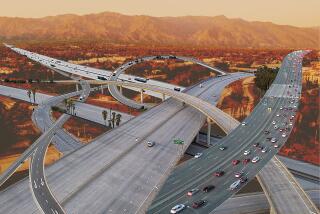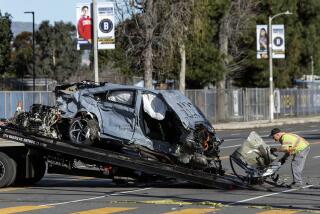Using cellphones to beat traffic?
A fleet of 100 cars rolled onto a Bay Area interstate Friday to begin perfecting a tool that could one day transform the lives of commuters around the world.
Maybe.
With San Francisco Bay shimmering to the west, university students drove the cars all day back and forth along Interstate 880. Each was carrying a cellphone loaded with Global Positioning System software. And as they drove, it beamed back signals that researchers shaped into a real-time map of traffic speeds.
Of course, maps of freeway conditions already exist and are popular. Who doesnât know about SigAlert.com or Google maps?
But in the ubiquitous cellphone, some researchers see a two-way device that can not only gather high-quality data on whatâs happening on the road, but then deliver information to motorists on which route they should take to shave time from their travels. âGetting that information back to the drivers, thatâs the Holy Grail -- so drivers can make smart decisions about their commute,â said Thomas West, director of the at UC Berkeley, one of the backers of Fridayâs experiment.
Not surprisingly, the main sponsor was Nokia, which sells about 450 million cellphones each year. With GPS expected to become a regular feature on cellphones, Nokia officials are trying to develop more applications that users may want.
âIt would be great if the phone, instead of saying go left or right, would say youâre meeting so-and-so at 10 a.m. and because traffic is picking up, you should leave now and you should avoid [a particular] exit because traffic is backing up,â said Bob Iannucci, Nokiaâs chief technology officer.
Some transportation officials believe the technology may be helpful, but they are skeptical about its ability to substantially ease commutes. They say that in many instances itâs doubtful that a machine can tell savvy motorists anything they donât already know from years of driving.
âDuring the peak of the peak of the commute all the roads are pretty much congested, and if a road isnât congested and it goes anywhere, people will find itâ without the aid of a computer, said Shawn Turner, a traffic engineer with the .
Turner, nonetheless, believes the technology is worth pursuing but may work best for those driving in unfamiliar areas or to help alert motorists to accidents during times when traffic is heavy.
The push by high-tech firms coincides with a decades-long effort in many cities to squeeze more capacity out of existing roads because it has proved difficult to find the money, space and public support for building new ones. As a result, one strategy has been to encourage motorists to use roads more efficiently.
Since the 1970s, the California Department of Transportation has installed thousands of sensors below freeways to monitor traffic. Information from those sensors allows the extrapolation of traffic speeds, which are displayed on traffic websites.
But sensors, which are expensive to install and can break down, are in short supply on some freeways. And that has led many to believe that the better way to electronically measure traffic is to put monitoring equipment inside vehicles. The other big advantage is that GPS also allows vehicles to be tracked on surface streets.
If such data can be sufficiently crunched and combined with existing sensor data, researchers hope to build a service that tells people how to get from point A to point B in the shortest time.
âAs a user you are not only contributing to the data, but you are benefiting from it by looking at it in real time on your phone,â said Alexandre Bayen, an assistant professor in civil engineering at UC Berkeley who is heading the project.
As part of Fridayâs experiment, which Bayen said was successful, the cellphone data was stripped of personal information to alleviate concerns that Big Brother -- or perhaps a divorce attorney -- could ever use the information to show that a person who said he was driving to the grocery actually strayed off-course.
Iannucci, of Nokia, said smaller-scale experiments have been successful and the next step would likely involve a road test on an even larger scale for a longer time. As to how soon the company could bring a product to market, Iannucci said he couldnât predict, but that Nokiaâs research arm generally works in two- to seven-year time frames.
It remains to be seen if cellphones will be the device that consumers favor. The Sunnyvale-based firm will soon begin selling an in-car directional system -- with a screen much larger than a cellphoneâs.
It also uses similar technology to recommend to motorists the three best ways to get to their destination, based on real-time highway speeds gathered from road sensors and other Dash system users.
âWhat you want to know as a consumer is a solution -- you donât just want a bunch of data,â said Rob Currie, the companyâs president and chief operating officer. âYou want to know that, today, this is the best route home.â
Currie believes his systemâs larger screen will make it preferable to cellphones. Others, however, suggest there may come a day when cellphones can be plugged into in-car computer screens that some expect to become more prevalent.
Another question is whether any real-time data can actually reduce commute times, particularly if everyone begins using it. One answer may be found in the sprawling, auto-dependent Houston area.
Houston Transtar, a partnership of four government agencies that oversees roadways in the region, has for several years produced electronic maps with traffic speeds. The maps -- which got 12 million web hits in January -- are generated by tracking cars that have toll-road transponders, even when they are not traveling on area toll roads.
That, in turn, allows the agency to offer a service that tells motorists exactly how long their commute will take on a particular freeway. Officials donât think the system has reduced traffic, but they believe motorists are using the information and that has helped prevent traffic from worsening. But Transtar has stopped short of offering alternative routes. Officials say it goes against the nature of Texas to tell people where they should drive. Also, for liability reasons, they donât want to get into the business of steering traffic off freeways and through communities that donât want short-cutters.
âWeâre trying to give drivers enough information to make those decisions themselves,â said Jack Whaley, the director of Houston Transtar. âIf someone is commuting, they know all the alternatives. People arenât stupid.â


